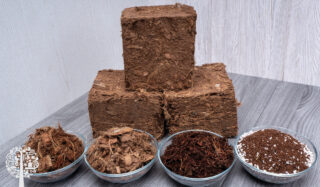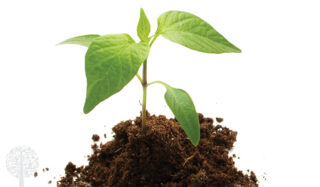Soilless SmackDown: Peat Moss versus Coco Coir
Whether you are cuckoo for coco or partial to peat, both growing media have demonstrated their suitability in growing for decades. Both growing media remain popular despite significant public attention regarding their sustainability. Arguably, both media command a large ecological footprint. If managed and manufactured responsibly (adhering to harvesting restrictions, composting or recycling spent media, better worker safety, reduced transportation, etc.), peat and coco are significantly better environmental choices than the most common grow medium with growers — stone wool (Rockwool), which is rarely repurposed or recycled.
Desirable Properties
Irrespective of the sustainability of these hydroponic growing systems, some integral properties are requisites for growing healthy and high-yielding crops. Quality plants need a high porosity substrate, and many roots prefer a well-aerated environment to allow for increased lateral growth. The ample pore space engineered within the media is critical in reducing the likelihood of root pathogens like Pythium spp. and Fusarium spp. taking hold. The physics of soilless mixes cannot be underestimated because, unlike natural soils with sufficient microbial populations to help engineer soil structure, soilless mixes rely on the proportion or size of materials added to provide structure. Soilless mixes should not be prone to oversaturation. Still, they should be able to maintain a moderate water content between irrigations. This is one of the most vital factors used by growers when crop steering plants from vegetative to generative growth. Beyond the physical components of a high-quality soilless mix, being chemically balanced and the media’s ability to hold and release nutrients over a short time are other factors to consider.
Not The Same

Most growers have equal success using preformed-stabilized plugs for cuttings (i.e., “clones”) establishment or seed germination, whether peat or coco-based. Depending on your cultivation strategy (e.g., “Sea of Green” – high plant density, reduced vegetative periods versus longer vegetative periods, and taller plants with a lower plant density), growers will plant rooted clones directly into their final pot size or choose an intermediate container until a final pot-up. It is essential to recognize that the air and water-holding capacities of a growing media are impacted by the geometry of the container (depth and width), with air-filled porosity increasing with container height. For growers, this correlates with the amount of water readily available to the plant, and perhaps more importantly, the amount of water we can add without leaching decreases with container height. In some cases, growers will overwater their containers, creating a saturated bottom half of the container and an underwatered top horizon, mainly when basing their watering frequency on the legacy practice of lifting pots. Growers who switch between coco and peat-based soils or different container sizes can often find themselves in flux between over and underwatering because of the assumption that these two growing media behave the same.
Cuckoo For Coco Coir
Horticultural growers have rapidly accepted coco coir-based growing media. Initially presented as an alternative to peat moss, cultivating using coco coir is not a simple substitution for replacing one growing media with another. Don’t think coco is simply a different form of peat — your cultivation practices will differ to ensure optimal plant health and yields. The most common forms of coco substrates include loose coco coir; coir mixed with perlite; expandable coir blocks that are pressed and contain coir pith, the husk fiber, and husk chips; and performed coir blocks, slabs, and grow bags. Coir’s popularity and primary divergence from peat is in its water-loving (hydrophilic) property, which is in direct contrast to the hydrophobic nature of peat. Coco usually does not require a wetting agent, naturally allowing for water tension to be reduced and spread evenly throughout the media. The ability of coco coir to not only readily absorb water but to re-saturate, similar to stone wool, allows for the employment of crop steering irrigation techniques, like frequent irrigations and dry-back. As a result, growers comfortable with a cultivation strategy that permits frequent waterings can reduce their substrate size, thereby allowing them to potentially reduce their production costs.
Know What You’re Working With
Despite these beneficial attributes, experienced growers transitioning to coco from other media often have disastrous results. Equating coco as a direct substitute for peat or stone wool can lead to nutrient deficiencies or watering issues. Not all coco is created equal. Coco products vary greatly, ranging from fine dust to large chunks. Some of this variability is specific to brands. You must remain consistent with your coco brand choice until you have done sufficient R&D to determine if an alternative brand will work. But variability, unfortunately, happens within a brand with specific batches containing finer particles, creating increased water retention and poor aeration of the root zone. Moreover, certain batches can have higher levels of sodium (Na), potassium (K), chloride (Cl), heavy metals, and even pathogens.
Coco coir containing high levels of these salts can cause visible nutrient disorders or slower growth and development. As such, many coir manufacturers will wash and/or buffer or charge their coco by either using water to leach out some of the excess salts or calcium (Ca) and magnesium (Mg) to bump off the Na and K.
What About Peat?
Where coco, if the right proportion of fine and coarse fibers are mixed, can be used as a sole ingredient, peat moss cannot. Peat-based growing media will typically incorporate coarse bog materials to accompany the many species of Sphagnum moss in the bog. These chunkier materials, often along with bark mulch, “green” wood fibers, compost, perlite, and/or vermiculite, help peat-based substrates from compaction or shrinkage.

Compared to stone wool and coco coir, peat moss has a high buffering capacity for water, pH and nutrients, and unlike coco coir, peat is acidic, hydrophobic and low in nutrients. As such, most peat-based substrate manufacturers will use a liming agent (e.g., calcitic or dolomitic limestone), a synthetic wetting agent (to help water become wetter), and a slight nutrient charge. For novice growers, using a high-porosity peat-based substrate can be more forgiving in terms of messing up the nutrient balance and pH around the root zone.
A Personal Choice
Far from a “SmackDown”, as both peat moss and coco coir have their merits and drawbacks, much of the decision to choose one over the other will be based on individual preferences and philosophical values. We must recognize that coco and peat are substitutes but not interchangeable. Growers must tweak their cultivation strategy to get the most out of their substrate.




